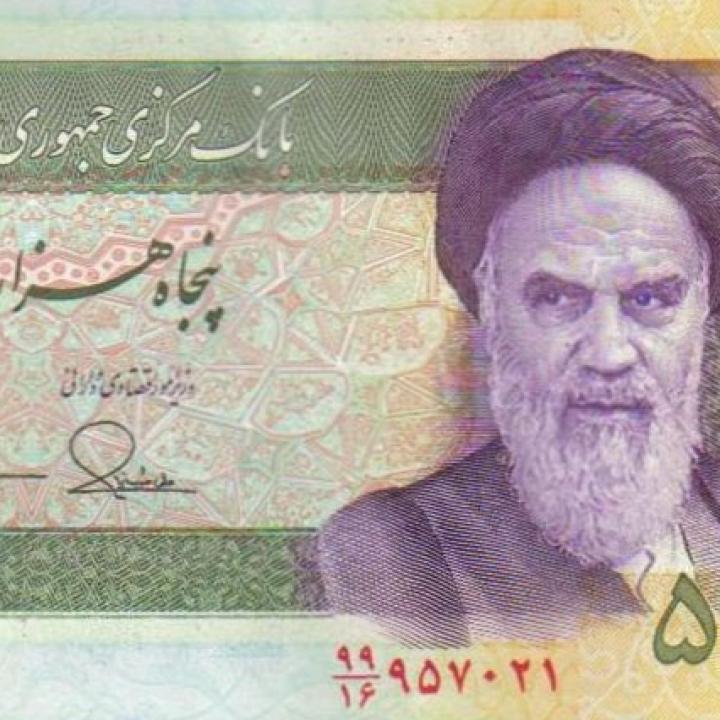

Findings from a new IMF report imply that greater U.S. pressure would have considerable impact on the country's shock-prone economy.
On March 29, the IMF released a report stemming from its latest "Article IV consultation" with Iran. Highlighting the country's economic vulnerabilities, the report emerges at a time when the Iranian rial has been under sustained pressure. The rial-to-dollar exchange rate on the free market slid from 4275 in January to 4875 on February 13, prompting the Central Bank to step in. Although the rate recovered to 4469 by March 1, it soon collapsed again to 4784—12% below where it started the year. The report also noted that Iran faces high risk from a host of other factors, including "uncertainties" related to implementation of the nuclear deal, "financial strains from inadequate progress on banking sector recapitalization and restructuring," and a steady weakening in "political or social support for reform."
Tehran can do much to insulate Iranians from most of the country's macroeconomic problems, which do not immediately translate into reduced living standards. Yet a financial crisis could affect most of the population rather quickly if banks are unable to make loans or pay cash to depositors.
In that regard, the IMF report discussed a host of grave dangers to Iran's banks. Their capital-to-assets ratio continues to decline (currently 4.9%), while nonperforming loans continue to grow (11.4%), and neither trend is likely to reverse. Noting that "the cost-to-income ratio for banks in Iran is amongst the highest in the world," the report called on the government to "refrain from directed credit," that is, telling banks to whom they can lend. It also recommended covering interest subsidies, adjusting regulated prices so that firms can meet their obligations to banks, and ensuring that state banks implement proper "governance, internal procedures, and credit risk management" in order to "support a profitable business model."
None of those measures seems likely to happen, however, so it is little wonder that worried depositors have been taking their money out of banks and using it to buy dollars. According to the IMF, at least two "credit institutions"—most of which are connected to clerics or the Islamic Revolutionary Guard Corps—have experienced "bank runs" recently. Iran does not have deposit insurance, though the Central Bank "lent" the two affected institutions enough to repay 98% of the depositors (i.e., those with less than $25,000). Yet the Central Bank has no prospect of getting the money back, and depositors cannot be sure what will happen during the next crisis.
In addition to bank mismanagement, the government's finances are more precarious than previously acknowledged. A years-long audit has found government payment arrears totaling more than 30% of GDP, bringing the debt-to-GDP ratio up to 50% even before the required bank recapitalization. As the IMF concluded, the country's "fiscal vulnerabilities have increased." For example, if a shock caused Iran's economy to decline 1.5% (instead of the projected 4.0% growth), it would drive debt to 84% of GDP in 2019, requiring the government to borrow sums that would exceed 20% of GDP that year alone.
These formidable risks do not even factor in the problem of maintaining a pension system in a country with a rapidly aging population. To quote the IMF report, "The three largest [public] pension schemes (90% of the system) are insolvent." Two of them require annual budget transfers equal to 1.6% of GDP, and the third will deplete its reserves by 2027.
In short, Iran's economy is highly vulnerable to external shocks such as oil price drops or toughened international sanctions. The mass protests in December-January showed that citizens blame the entire political system for the economic problems, so worsening conditions would likely sour the public mood even further.
Alternatively, more-competent Iranian governance could do much to resolve the economic problems, since the necessary reforms are well known and potentially dramatic in their effects. Amending the Customs Law and improving infrastructure would help stimulate production by slashing the time it takes to clear exports (currently twenty-five days). Even a simple step like passing a new banking law would probably stave off the risk of a banking collapse, especially if it establishes deposit insurance and makes the Central Bank less vulnerable to political pressure. Social changes could help as well—the IMF estimates that closing the employment gender gap by half "could boost GDP by 26%."
Yet the pace of financial reforms has been glacial due in large part to political paralysis, with each faction determined to protect its ill-gotten gains even if they leave the Islamic Republic more vulnerable to U.S. pressure. If Washington decides to increase Tehran's economic stress, history suggests that the government would publicly blame America for the country's economic problems. For their part, the Iranian people would likely blame both the regime's hardline policies and Washington's hostility. The political impact of U.S. pressure would therefore depend on who wins that blame game.
Patrick Clawson is the Morningstar Senior Fellow and director of research at The Washington Institute.



